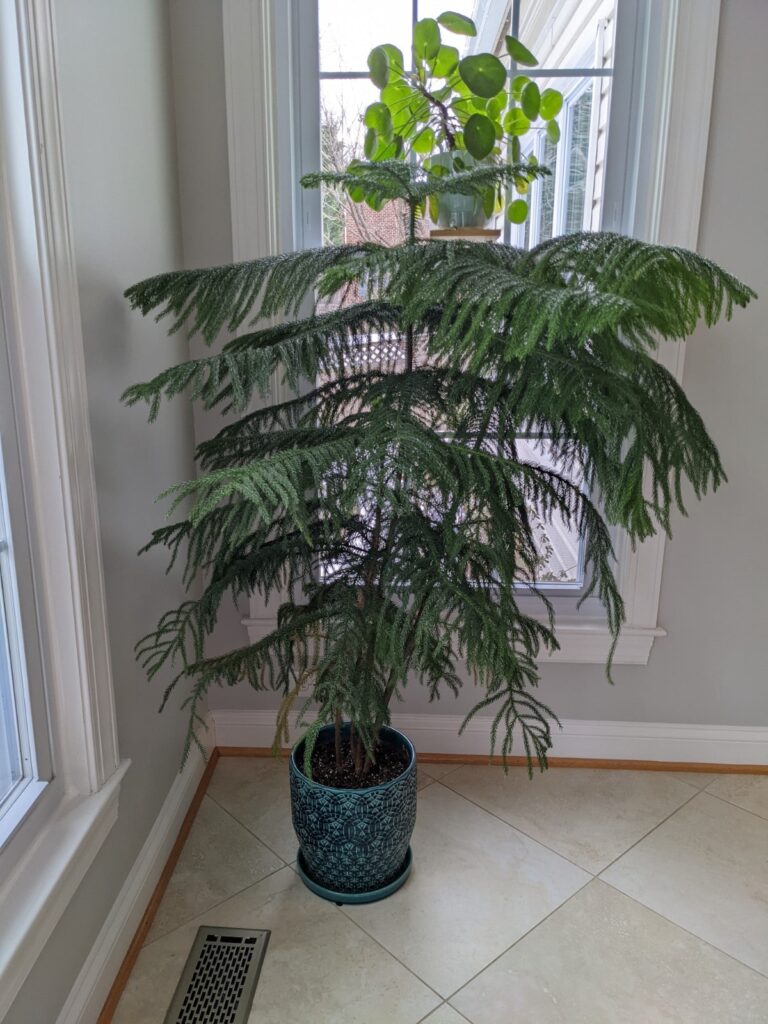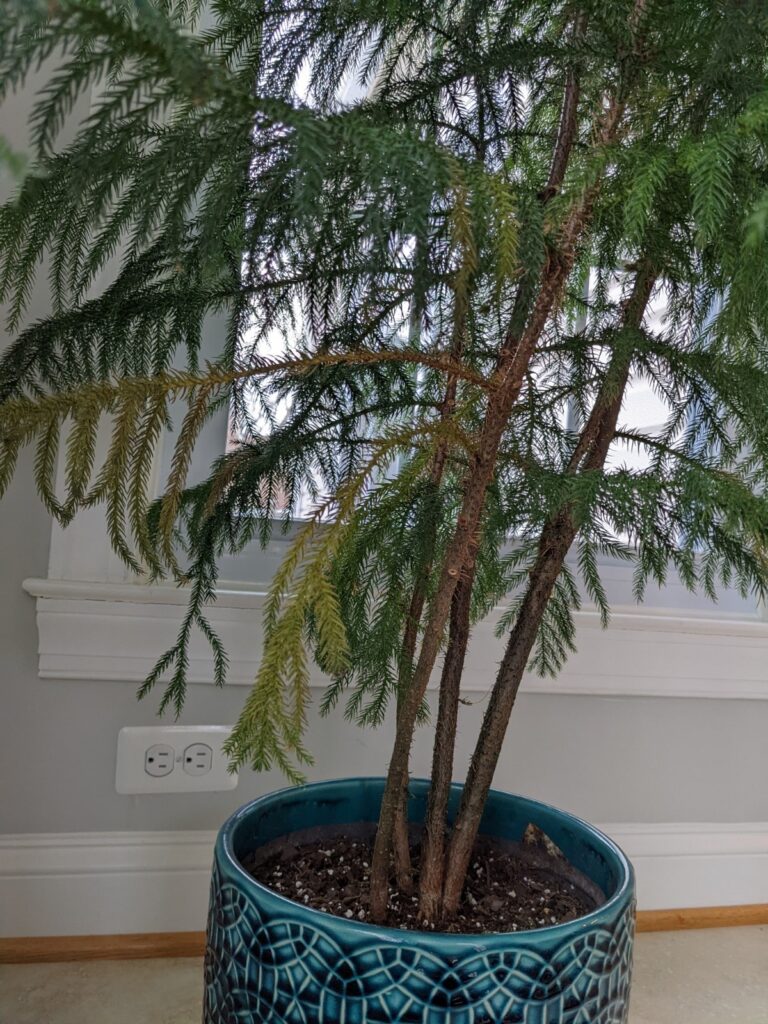Diagnosing and Fixing Norfolk Pine Problems
I have always loved Norfolk Pines as houseplants. Around the holidays you can find them everywhere, sometimes sprayed with glitter ugh, because they look like Christmas trees. About six years ago I failed twice at keeping a Norfolk Pine alive. It was my white whale of a plant. Luckily, the next year I decided to give it one more try and I have been successfully growing a Norfolk Pine for five years! Based on my early struggles and later success I wanted to write this post for others looking to fix their Norfolk Pine problems.

Common Norfolk Pine Problems
Norfolk Pine Yellowing
If I had to guess, most of you are reading this post because you have this Norfolk Pine problem. Norfolk Pines with needles that are turning yellow or brown and eventually crispy. This may happen to one little stem or an entire branch. Unfortunately for me, I'm currently having this problem this winter. The silver lining of that is that I can show you a picture of a Norfolk Pine yellowing.

As you can see there are two lower branches that have begun to turn yellow. Then they start turning brown and getting crispy. These branches will die off. I did not notice this soon enough or I may have been able to prevent these branches from dying.
Why is my Norfolk Pine Yellowing
Norfolk Pine Moisture Issues
Norfolk Pines like evenly moist soil. They are actually tropical plants and are not like the Pine trees you typically think of. Norfolk Pines also like pretty high humidity air as well. Improper moisture will cause your Norfolk Pine problems which may result in yellowing. Once a stem or branch is yellow, it cannot be undone typically, but you can prevent it in the future.
Too much or too little soil moisture can cause Norfolk Pine yellowing. In my case, it's always been too little moisture because Norfolk Pines like to be way more moist than most of my houseplants. To keep on top of soil moisture you have to be checking your plant's soil moisture frequently. You can do so with your finger, sticking it about two knuckles down to feel soil moisture. Water when it feels dry. If you like more precision, and maybe don't want to get dirt in your fingernail every day, use a cheap soil moisture meter. This is easily my most used plant accessory. For a Norfolk Pine, you want to keep the soil moisture in that middle moist range.
Some other tips for maintaining proper soil moisture are to have the right pot and soil. The pot should be appropriately sized for the root ball, no more than two inches larger that the root ball else the soil may become too moist. The pot should also have drainage. A lot of times I recommend terracotta pots because they are porous and dry out quickly, but for a moisture loving plant like the Norfolk Pine, that's a bad thing. Norfolk Pine soil should hold moisture but also have drainage. You want to make your own or look for a blend that has more peat moss which holds moisture.
It can be really tough to keep your Norfolk Pine moist enough in the winter. When your heat is running it dries out the air and that's when I often get issues. Especially since my Norfolk Pine is near a floor register that's blowing heated air. Not smart, I know! You can help combat the dry air with a small humidifier. I really like these portable humidifiers because they are really easy to move around and keep clean. Big humidifiers have tanks and tubing that get really gross over time.
Norfolk Pine Fertilizer Issues
Nutrient issues can also cause Norfolk Pine problems. Norfolk Pine yellowing could be due to over or under fertilization. It can be difficult to tell which is the culprit. If you have been following the directions on your fertilizer regarding frequency and dilution, you probably aren't over fertilizing. It's also important to note that you shouldn't be fertilizing during the winter while the plant is dormant.
You can be completely sure about your soil's nutrients if you use a soil rapitest. This is a nice little test kit to give you accurate levels of n-p-k, or nitrogen, phosphorus, and potassium. It also tests the ph. If you are really deficient in one nutrient, you may want to get a fertilizer that has a high ratio of that nutrient. However in general, Norfolk Pines do well with a balanced fertilizer that has roughly the same ratio of all three nutrients.
Norfolk Pine Pest Issues
Unfortunately Norfolk Pines are susceptible to all of the bugs aphids, scale, mites, and mealybugs. Pests are the number one reason to closely inspect your plants on a regular basis. A lot of times we don't notice until the infestation is too late. If you do spot pests then follow the steps below to rid yourself of them.
The very first thing you need to do after spotting a pest is to quarantine it. Pests can spread from one plant to another through the air or hitchike on your clothes or a pet. Once you have quarantined, you should try to remove as many pests as possible. For spider mites and aphids you can take you plant outside and spray it with a hose or take it in your shower and do the same thing. If you have scale or mealybugs you have to manually pick them off. You can use an alcohol dipped cotton swab to kill them as well.
Once you have removed the pests that you can see, you need to treat your plant with an organic pest control like neem oil or non-organic insecticidal soap. Follow the directions completely. You must reapply your pest control multiple times and monitor for weeks. These pests have short lifespans which means new eggs can be hatching days after you killed the living pests. Then you'r reinfested, which you don't want.
Hopefully this helps you diagnose and fix your Norfolk Pine problems. Share in the comments.
Add new comment